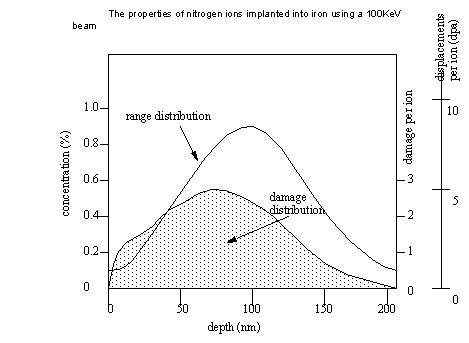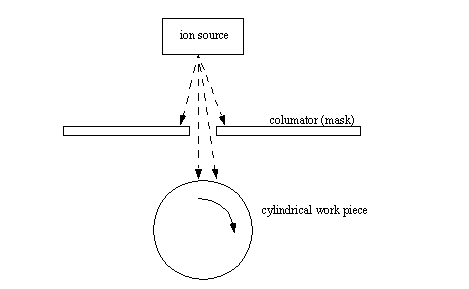1. ION IMPLANTATION• original application was doping semiconductors with boron, arsenic, phosphorous, etc. • Ions can be implanted with electron beams or lasers. • Ion penetration is a result of high energy ions arriving at a surface. The penetration depth is a function of energy (10-200 KeV typically) and collisions with the target matrial lattice. • Typical impacts, and impact depth are depicted in the figure below, [source, unknown] 
• Energy is dissipated in two ways, - elastic deformation of the lattice • The beam penetration basically has a gaussian distribution about some central value. • After the ion enters the surface it may collide with a number of atom, knocking them out of location and strain hardening the material. The ions will eventually come to rest at some depth in the material. • The radiation effects causes a loss of energy as the incident ion beam strikes and displaces target atoms. • Sputtering is the effect where incoming ions are reflected back in their direction of origin, and if energetic enough they will leave the surface. • The cascade effect involves an ion with sufficient energy colliding with one atom, in turn causing more collisions. • The implanted ion results in surface stress, and when concentrations are high enough, this can lead to partial deformations. 
• A columator is in use to prevent ions from striking the surface at shallow angles and sputtering. • The workpiece is rotated to ensure good surface coverage • One high dose source can be replaced with a number of lower dose systems. - low temperature processing reduces handling an stress problems. - good adhesion of treated surface - can improve corrosion, oxidation, wear, hardness, friction, fatigue - very shallow treatment (< 1 μm) - the surface can be weakened by radiation effects - Nitrogen implantation has been used to increase wear resistance and give longer life, - yttrium gives oxidation and wear resistance - titanium and carbon on iron gives lower friction and better wear. - chromium is used to maintain strength of holes. • After layers of materials have been implanted the surface can be bombarded with another ion beam that causes collisions and better mixes the implanted ions more uniformly in the surface. This technique is known as ion beam mixing. • Ion beam enhanced deposition (IBED) uses normal surface deposition techniques and an accompanying ion beam that increases the thickness of the deposited layer, and bonding between the new layer and the existing material. 1.1 THIN LAYER DEPOSITION1.2 PRACTICE PROBLEMS |